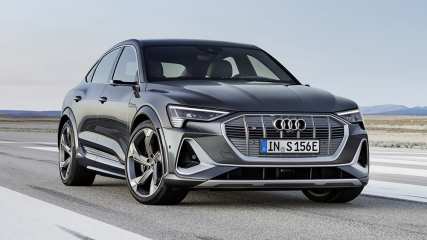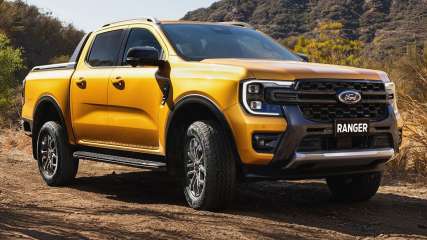BMW 1600 Reviews
You'll find all our BMW 1600 reviews right here. BMW 1600 prices range from $1,980 for the 1600 to $4,070 for the 1600 .
Our reviews offer detailed analysis of the 's features, design, practicality, fuel consumption, engine and transmission, safety, ownership and what it's like to drive.
The most recent reviews sit up the top of the page, but if you're looking for an older model year or shopping for a used car, scroll down to find BMW dating back as far as 1967.
Or, if you just want to read the latest news about the BMW 1600, you'll find it all here.
BMW Reviews and News

What's in a name? Why it looks like car companies have run out of good names | Opinion
Read the article
By Stephen Ottley · 12 Nov 2022
Naming cars used to be simple - either you picked some evocative names (think Mustang, Falcon, Monaro, etc) or a sequence of numbers and/or letters (think 3 Series, C-Class, A4, etc) - but these days it feels more like car names are randomly selected by marketing teams rushing to get to the weekend.
.jpg)
BMW X1 2023 review
Read the article
By Byron Mathioudakis · 10 Nov 2022
One of the earliest examples of a premium small SUV, the original X1 of 2010 established BMW as a canny marketer, but the model never won the acclaim of newer alternatives. Now, the completely redesigned third-generation U11-series X1 aims to change this, with a longer and wider platform, larger body, advanced powertrains and innovative cabin promising more space, refinement and agility.

About time! BMW extends general warranty at long last on BMW, Mini and BMW Motorrad motorcycles in Australia
Read the article
By Byron Mathioudakis · 07 Nov 2022
BMW has finally increased its warranty to five years, with unlimited kilometres as part of the deal.
.jpeg)
Electric car regenerative braking: How does it work?
Read the article
By Stephen Corby · 05 Nov 2022
You’ve no doubt heard the term, but just what is regenerative braking?Regenerative braking is how an electric vehicle captures kinetic energy created when the car slows down, either transferring it directly to the electric motor or storing it in the battery pack for future use. Although electric vehicles receive lashings of praise due to the obvious benefits — running a car on electricity is cheaper and far friendlier to the environment than a comparable internal-combustion engine (ICE) car — one issue keeps circling them like vultures eyeing off someone lost in the desert.And that is, how to find a charger to keep them powered up. Since EV-charging infrastructure isn’t quite where it needs to be at yet, especially in a country as expansive as Australia, there’s understandable concern around how to keep them sufficiently charged, especially during longer journeys. Engineers far smarter than us have come up with technology to alleviate this problem in the form of regenerative braking, an ingenious process used in EVs — whether that’s a hybrid, plug-in hybrid electric vehicle (PHEV) or all-electric vehicle — where kinetic energy captured when the vehicle slows down is converted into power that the car can utilise. Regenerative braking can’t provide as much power as plugging an EV into an external source like a charging station, so it’s not a complete solution, but what it can do is continually top up your EV’s battery without you having to plug it in, which is a huge help in extending your driving range. In a traditional ICE car, the brakes are used to slow the vehicle down, with kinetic energy created by the car’s movement converted into heat via the friction of the brake pads, which then dissipates into the air — wasted energy, as it were. Like ICE cars, electric car brakes consist of a brake pedal, hydraulic brakes, and disc brake calipers that clamp the brake rotors to help you to stop.Coupled with this is a regenerative braking system, which uses the motion of the wheels when the vehicle is slowing down to capture kinetic energy that is sent to the electric motor. This kinetic energy turns the motor shaft, with the motor acting like a generator.The kinetic energy is converted into electrical energy by the motor, which is either instantly utilised or sent to the battery to be stored and used when needed. Some EVs also have buttons or paddles which control the strength of the regenerative braking, with more sudden stopping naturally creating more kinetic energy than gently slowing down. The sudden stopping is a boon for generating power, but be warned, it can be a jerky experience, and anyone eating food or drinking while it’s happening may want to think twice, lest they wind up wearing it. Just to confuse things a little, there is an electric braking system that uses ‘brake-by-wire’ technology, where the mechanical and hydraulic components of traditional braking systems are replaced by electronic sensors and actuators to carry out the braking. Does that have anything to do with regenerative braking? Not really, but at least you’ll be well equipped if you’re confronted with a pub trivia question regarding the difference between electric brakes and regenerative braking (if you do face that question, we might quietly suggest that you change pubs, pronto).For all intents and purposes, an electric motor that provides propulsion and a generator that creates electricity are mechanically the same, which is why EVs have a component that is typically referred to as a ‘motor-generator’. In EVs, the process of regenerative braking kicks in as soon as you take your foot off the accelerator, the electric motor then switching over to act as a generator. The effort it takes to turn the generator requires the car to slow down significantly, meaning you may not even have to press down on the brake pedal to stop. Thus, the term ‘one-pedal driving’ was born, since the accelerator acts as a kind of brake once you take your foot off of it, with the single pedal being used to speed up and slow down the vehicle. While hybrids and PHEVs also have regenerative braking, full one-pedal driving is usually only available in fully electric cars.When it comes to Tesla, regenerative braking is standard in all of its cars. Other EVs that utilise regenerative braking include the Hyundai Kona Electric, Audi e-tron, Nissan Leaf, BMW i3 and Jaguar I-Pace. In fact, pretty much every vehicle with a hybrid, plug-in hybrid, or fully electric drivetrain uses regenerative braking in some form.
.jpg)
BMW M Performance Parts for the new BMW M2
Read the article
By James Cleary · 01 Nov 2022
The new BMW M2 is coming to Australia in the first half of 2023, and the factory in Munich has announced a range of 'M Performance Parts' for those wanting a more hardcore and individual experience.
.jpg)
Has BMW finally cracked the successful electric car code? Why the iX1 might be the best-buy German electric SUV going
Read the article
By Byron Mathioudakis · 01 Nov 2022
After years of trying and failing with worthy attempts like the i3 luxury hatchback and i8 supercar, BMW Australia seems to have finally found the right formula for electric vehicle (EV) success with the coming iX1.
.jpg)
Is Genesis about to go BMW Z4 and Mercedes-Benz SL hunting? 'A convertible would be our dream', according to luxury brand
Read the article
By James Cleary · 29 Oct 2022
It doesn’t take the deductive skills of Hercule Poirot or Jane Marple to confirm Genesis wants to add a GT-style sports luxury car to its global line-up.
.jpg)
Stick it to them! The battle for the BMW M2 Coupe to keep the manual transmission, but for how long?
Read the article
By Byron Mathioudakis · 27 Oct 2022
BMW has revealed that factions both within and outside of the company fought hard to maintain a manual transmission option in its best-selling M2 Coupe.

Five years on from the last Aussie car: Post-Holden, we want more utes, bigger trucks, electric cars, everything Toyota and cheapies from China
Read the article
By Byron Mathioudakis · 21 Oct 2022
This month marks five years since the final Australian-made car rolled off the production line. How have Australian car-buying habits changed since 2017? We explore how and why our tastes have changed so profoundly so quickly. It's been quite the ride!
.jpg)
Is the best-looking BMW electric SUV also the cheapest? Shock iX1 pricing set to spook Mercedes-Benz EQB, Genesis GV60 and other premium electric cars
Read the article
By Byron Mathioudakis · 21 Oct 2022
BMW Australia has released the pricing of its cheapest-yet electric SUV, as well as what might be the brand’s best-looking SUV since the original X5 of 1999.Kicking off from $82,900 before on-road costs, the iX1 lands in Australia early next year in just one grade, the all-wheel-drive xDrive30.This is provocative pricing, as it undercuts the new Mercedes EQB 250 front-wheel drive (from $87,800) and Genesis GV60 (from $103,700).However, the Tesla Model Y (from $72,300), Volvo XC40 Recharge Pure Electric (from $72,990) and Lexus UX 300e (from $74,000) remain substantially cheaper in their base (though two-wheel drive) iterations compared to the German-made BMW.With just an ‘I’ to differentiate it by name, the iX1 will be an adjunct to the third-generation, U11-series X1 to be launched next month in FWD sDrive18i and AWD xDrive20i turbo petrol-engined grades.As reported previously, only the single, highly equipped and specified xDrive30 grade will be released initially, with dual motors allowing for the AWD. Both are electrically excited synchronous motor set-ups.Combined, these deliver 230kW of power and 494Nm of torque, to propel the iX1 to 100km/h from standstill in 5.6 seconds, on the way to a 180km/h top speed. In contrast, the EQB 350 4Matic equivalent that starts from $106,700 needs another 0.6s to reach 100km/h and has a 20km/h lower maximum velocity.Similarly, even with a slightly smaller 65kWh battery pack, the xDrive30’s 440km range (WLTP) also beats the EQB (at 360km WLTP). Charging is via a Type 2 CCS port, capable of 130kW on DC and 22kW on AC.Using the WLTP standard, the combined fuel consumption is 18.4kWh/100km, compared to the EQB 350 4Matic’s 21.0kWh/100km. If you can find a 130kW DC charger, the battery pack can be replenished from 10 per cent to 80 per cent full in 29 minutes. Along with a so-called “Flexible Fast Charger” for charging at home as well as a Mode 3 charging cable, BMW Australia will also offer a three-year subscription to the Chargefox national network.BMW says the iX1 is its first compact model on a new flexible FWD-based architecture to feature a battery electric powertrain, and was specially designed to accommodate a large battery low down to improve the centre of gravity, benefit dynamics through improved weight distribution, as well as minimise interior-space impact.As a result, cargo capacity is rated at 490 litres, which is just 10L shy of the ‘regular’ X1.Additionally, BMW’s adaptive M Suspension and M Sport variable-ratio steering set-up will be fitted to the iX1, to provide what the brand reckons is a balance between handling agility and ride comfort.Equipment levels will also include active lane keep systems, adaptive cruise control, blind-spot monitor, surround-view cameras, adaptive LED headlights, a panoramic glass sunroof, premium Harmon Kardon sound system, a powered tailgate, rain-sensing wipers, a head-up display, 10.25-inch digital instrument cluster, a 10.7-inch multimedia touchscreen, wireless Apple CarPlay/Android Auto connectivity, dual-zone climate control, keyless entry/go, wireless smartphone charger, tyre pressure monitors, satellite navigation, BMW’s Intelligent Personal Assistant featuring voice control and 19-inch alloy wheels.The iX1 also adopts BMW’s latest Operating System 8 software interface.Buyers can choose between the xLine or M Sport trim packages at no extra cost.More information will be revealed closer to the iX1’s first-quarter release date.




